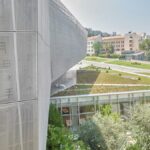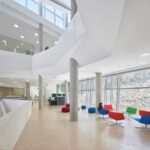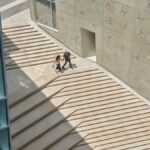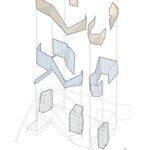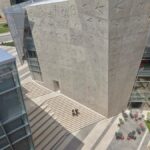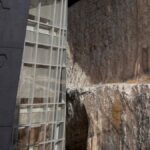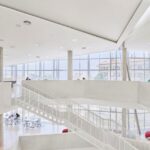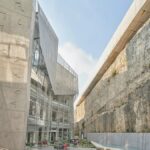Situated on the historic Byblos Campus, the J. G. Jabbra Library and R. Nassar Central Administration Building stand as a testament to Lebanon’s rich cultural legacy and architectural innovation. Designed by Atelier Pagnamenta Torriani, these structures pay homage to the region’s ancient heritage while embracing contemporary design principles.
Inspirations from the Past: Heritage and Light
Cultural Legacy
Perched above the ancient city of Jbeil, where the Phoenicians forged the world’s first phonetic alphabet, the Byblos Campus serves as a living testament to Lebanon’s storied past. Inspired by the rugged beauty of the excavated rock and the region’s layered history, Atelier Pagnamenta Torriani sought to integrate these elements into their architectural vision.
Harnessing Light

A central challenge in the design process was balancing Lebanon’s intense sunlight with the need for gentle, diffused illumination within the buildings. Drawing inspiration from the surrounding landscape, the architects positioned the library and administration buildings adjacent to the exposed rock, creating an open amphitheater bathed in natural light. This juxtaposition of natural and built environments infuses the space with a sense of harmony and tranquility.
Dynamic Forms: Layers and Transparency
Architectural Expression
The exterior design of the structures reflects their dynamic forms, with layered facades providing shade and optimizing interior lighting based on orientation. These multifaceted skins not only shield occupants from the harsh sun but also create a visually compelling interplay between solidity and transparency.
Seamless Integration
Internally, the library’s layout revolves around a spacious atrium that serves as a focal point, flooding the interior with daylight and facilitating natural ventilation. The seamless flow between indoor and outdoor spaces fosters connectivity and encourages interaction, while transparent elements blur the boundaries between inside and out.
Sustainable Solutions: Harmony with Nature
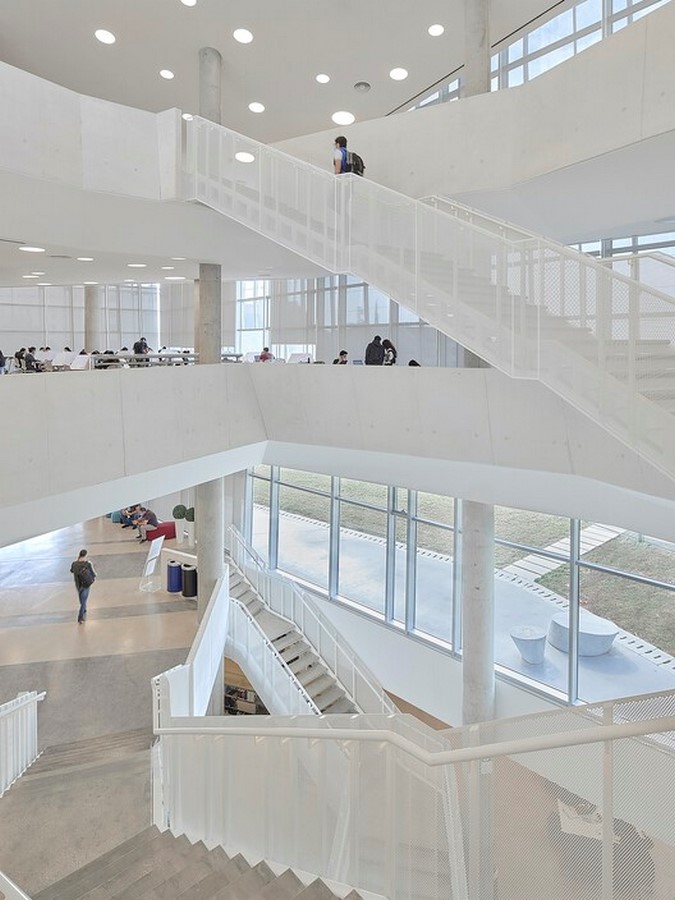
Passive Design
Drawing on traditional Lebanese architectural principles, passive features such as Mashrabiya-inspired screens and open atriums promote natural ventilation and light diffusion. By detaching the buildings from the rock face, the design harnesses the cooling sea breeze to ventilate outdoor areas, reducing reliance on electrical energy.
Environmental Stewardship
Incorporating photovoltaic solar panels further reduces energy consumption, aligning with Lebanon’s commitment to sustainability. These initiatives not only minimize the campus’s ecological footprint but also create a conducive environment for scholarly pursuits and social interaction.
Synergy and Wellbeing: A Space for Learning and Community
Scholarly Hub
The library and administrative spaces serve as a nexus for academic and social activities, fostering collaboration and dialogue among students and faculty. Designed to accommodate diverse forms of information exchange, these inclusive spaces promote learning, understanding, and cultural exchange.
User-Centric Design
Prioritizing user comfort and wellbeing, the architects have curated a serene atmosphere characterized by diffused light, accessibility, and panoramic views. From custom-designed furniture crafted by local artisans to ample study spaces both indoors and out, every element is tailored to enhance the user experience and foster a sense of belonging.
In summary, the J. G. Jabbra Library and R. Nassar Central Administration Building embody a harmonious blend of heritage and innovation, seamlessly integrating with their natural surroundings while providing a conducive environment for learning and community engagement. As testaments to Lebanon’s rich cultural heritage and commitment to sustainable design, these structures stand as beacons of architectural excellence and environmental stewardship.


